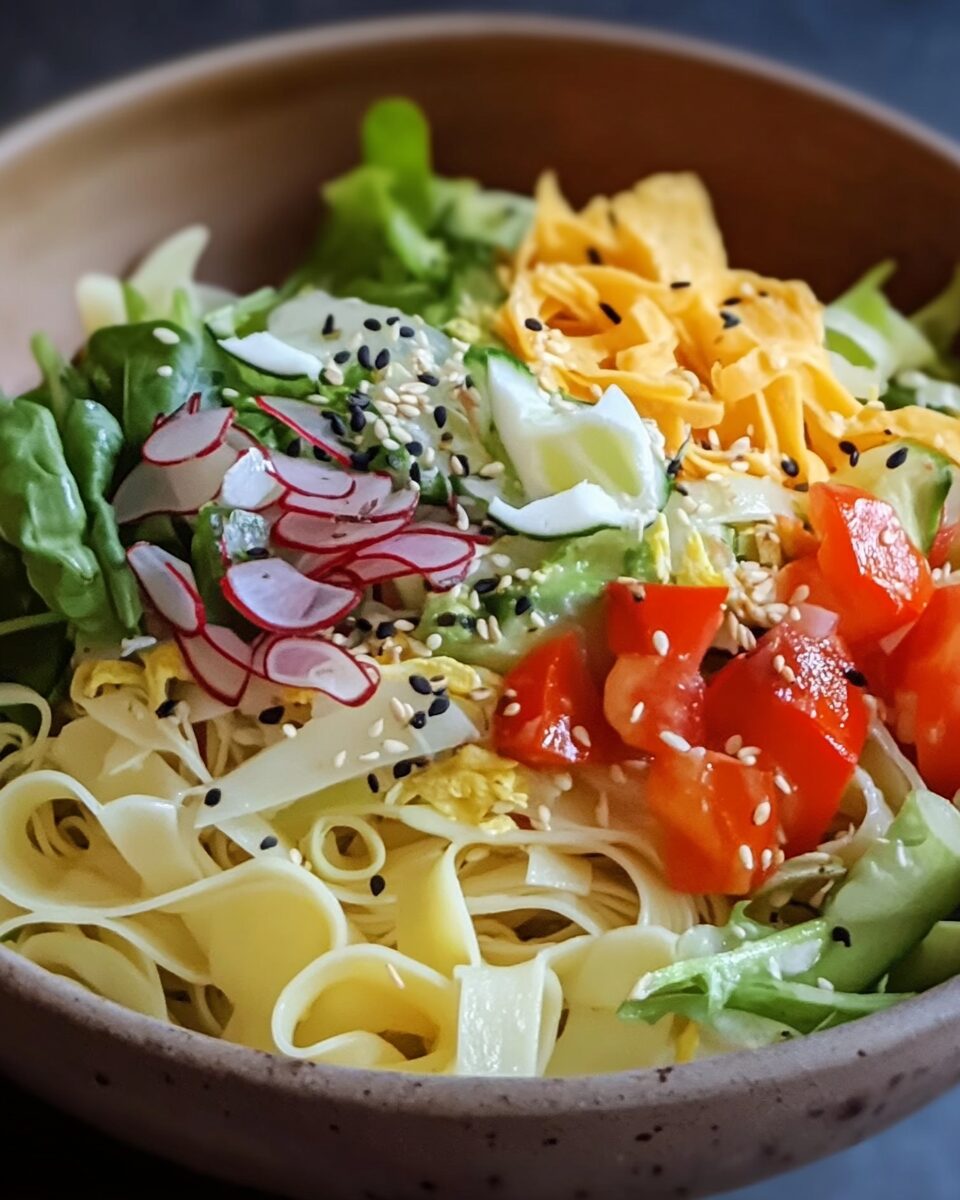Yuba Noodle Salad is a fresh and light dish that features yuba, also known as tofu skin, paired with crisp vegetables, herbs, and a tangy dressing. Yuba, which is made from soybeans, offers a unique texture and flavor that complements the crunchy vegetables and savory dressing in this salad. This dish is perfect as a refreshing lunch, appetizer, or side dish. It’s ideal for those seeking a healthy, plant-based meal that is full of flavor and nutrients, with a satisfying balance of textures. Whether you’re looking for a vegan-friendly dish or just something light and refreshing, Yuba Noodle Salad is a delicious choice.
Full Recipe:
Ingredients
- 1 package yuba noodles (tofu skin)
- 1 cucumber, julienned
- 1 carrot, julienned
- 1/4 cup fresh cilantro, chopped
- 1 tablespoon sesame seeds, toasted
- 1/4 cup rice vinegar
- 1 tablespoon soy sauce
- 1 tablespoon sesame oil
- 1 teaspoon sugar
- 1/2 teaspoon chili oil (optional)
Directions
- Prepare the yuba noodles according to the package instructions. Typically, this involves soaking the noodles in warm water until they soften, about 10-15 minutes.
- Once the noodles are ready, drain and set them aside.
- In a large bowl, combine the cucumber, carrot, and cilantro.
- In a separate small bowl, whisk together the rice vinegar, soy sauce, sesame oil, sugar, and chili oil (if using) to create the dressing.
- Add the prepared yuba noodles to the vegetable mixture and toss gently.
- Pour the dressing over the noodles and vegetables, then toss again to coat evenly.
- Garnish with toasted sesame seeds before serving.
Nutrients
- Calories: 140
- Total Fat: 8g
- Saturated Fat: 1g
- Cholesterol: 0mg
- Sodium: 350mg
- Total Carbohydrate: 14g
- Dietary Fiber: 2g
- Sugars: 6g
- Protein: 6g
The Origins and Tradition of Yuba in Asian Cuisine
Yuba is a popular ingredient in many Asian countries, particularly in Japan, China, and Korea. Its origins can be traced back to China, where it was made as early as the Tang Dynasty. The process of making yuba is relatively simple: when soy milk is heated, the protein in the milk coagulates and forms a thin layer of skin on the surface. This layer is then carefully lifted off, dried, and sold as yuba. It has been used for centuries in a variety of dishes, ranging from soups and stir-fries to desserts and salads.
In Japanese cuisine, yuba is considered a delicacy, especially in Kyoto, where it’s often served fresh or dried. It is commonly used in dishes like yudofu (hot tofu hot pot) or as a filling in sushi rolls. In Chinese cuisine, yuba is used in a wide variety of vegetarian and vegan dishes, often as a meat substitute due to its protein-rich content and texture. The versatility of yuba has made it a staple ingredient in many Asian cooking traditions.
While the use of yuba is traditional in Asian cooking, it has gained popularity in recent years in Western kitchens, especially among those looking for plant-based protein alternatives. Its ability to absorb flavors and provide a satisfying, chewy texture makes it an excellent ingredient for salads, soups, and even stir-fries.
Why Yuba Noodle Salad Is So Appealing
Yuba Noodle Salad is appealing for several reasons. First, it’s an incredibly light dish that feels refreshing and healthy. The delicate texture of the yuba noodles, combined with the crisp vegetables, provides a satisfying crunch that doesn’t feel heavy. The vegetables, such as cucumber and carrot, are not only full of vitamins and antioxidants but also help add a vibrant pop of color to the dish.
Second, the salad’s dressing is the perfect balance of tangy and savory, with the acidity from rice vinegar and the umami of soy sauce and sesame oil. This dressing brings all the ingredients together and adds depth of flavor, without overwhelming the freshness of the yuba and vegetables. If you prefer a bit of heat, the addition of chili oil gives the salad a slight spicy kick, which complements the other flavors beautifully.
Another reason why Yuba Noodle Salad is so appealing is that it’s incredibly versatile. While this recipe sticks to a simple and traditional vegetable mix, you can easily add more toppings or ingredients based on what you have on hand. You can incorporate edamame, bell peppers, radishes, or even tofu for added protein. This flexibility makes it a great option for meal prep, as you can adjust the ingredients according to what’s available or what you prefer.
Health Benefits of Yuba Noodle Salad
One of the biggest advantages of Yuba Noodle Salad is its health benefits. The primary ingredient, yuba, is made from soybeans, which are packed with nutrients. Soybeans are an excellent source of plant-based protein, making yuba a great option for those following vegetarian or vegan diets. In addition to being rich in protein, yuba contains important amino acids that the body needs for muscle repair and overall health.
The vegetables in this salad, such as cucumber and carrots, provide essential vitamins and antioxidants. Carrots are particularly rich in beta-carotene, which is important for maintaining healthy vision and skin. Cucumbers, on the other hand, are hydrating and full of fiber, which helps with digestion and keeps you feeling full for longer.
The dressing for the salad is made with rice vinegar, sesame oil, soy sauce, and lime juice. These ingredients offer numerous health benefits. Rice vinegar has been linked to improved digestion and blood sugar control, while sesame oil provides healthy fats that are good for heart health. Lime juice is an excellent source of vitamin C, an essential antioxidant that helps support immune function and promotes healthy skin.
Furthermore, the salad’s use of sesame seeds and crushed peanuts as toppings adds healthy fats and protein, as well as a satisfying crunch. Peanuts, in particular, are a good source of monounsaturated fats, which are beneficial for heart health, as well as fiber, which helps support digestion and regulate blood sugar levels.
Customization and Variations of Yuba Noodle Salad
Yuba Noodle Salad is extremely customizable. Depending on your preferences or dietary needs, you can easily adapt the recipe to suit your taste. Here are some ideas for customizing the salad:
-
Add More Protein: If you’re looking for a more filling meal, consider adding protein to the salad. Grilled chicken, shrimp, or even tempeh would complement the yuba noodles and vegetables beautifully. For a more traditional touch, you can also add tofu to the salad for added texture and protein.
-
More Vegetables: The recipe calls for cucumbers and carrots, but feel free to add any other vegetables you enjoy. Bell peppers, snow peas, and radishes all make great additions and add a fresh crunch to the salad.
-
Adjust the Spice Level: If you enjoy a bit of heat, you can increase the amount of chili oil or add fresh chili peppers to the dressing. For a milder version, simply omit the chili oil or use it sparingly.
-
Switch up the Dressing: While the sesame oil-based dressing is traditional, you can experiment with other dressings as well. For example, a peanut dressing or a lime and cilantro dressing would add a new flavor dimension to the salad.
-
Herb Variations: In addition to cilantro, you can use other fresh herbs such as mint, Thai basil, or parsley to add more fragrance and depth to the salad. Fresh herbs play a key role in Vietnamese and Southeast Asian cooking, and their bright, aromatic flavors elevate the overall dish.
Serving and Pairing with Yuba Noodle Salad
Yuba Noodle Salad is perfect on its own as a light meal or side dish. However, you can pair it with a variety of other dishes for a more complete meal. Here are some serving and pairing suggestions:
-
Side Dishes: Pair the salad with other Asian-inspired dishes such as spring rolls, dumplings, or a simple miso soup. These light, flavorful dishes complement the fresh, tangy notes of the Yuba Noodle Salad and create a balanced meal.
-
Protein Additions: As mentioned, you can add grilled protein such as chicken, shrimp, or tofu to the salad to make it a more substantial meal. These proteins work well with the fresh, crunchy vegetables and the savory dressing.
-
Drinks: Yuba Noodle Salad pairs wonderfully with light, refreshing beverages. Consider serving it with iced green tea, coconut water, or a simple limeade. For an alcoholic drink, a crisp white wine, like Sauvignon Blanc, or a light beer, such as a pilsner, would complement the fresh flavors of the salad.
-
Garnishes: Top the salad with extra sesame seeds or crushed peanuts for added crunch. Fresh herbs like cilantro and mint also make an excellent garnish, adding a pop of color and flavor to the dish.
Conclusion
Yuba Noodle Salad is a fresh, vibrant dish that perfectly balances flavors and textures. With its light yuba noodles, crisp vegetables, and tangy, flavorful dressing, this salad is a healthy, satisfying meal that is perfect for warm weather but versatile enough to enjoy year-round. It’s an excellent choice for those looking for a plant-based dish, but it’s also adaptable to various dietary preferences.

